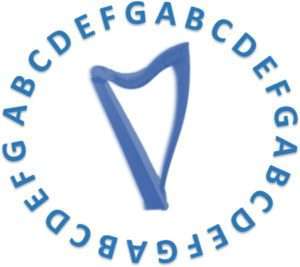Keeping the Ledger (Lines)
Does the mere thought of having to read Ledger Lines make you faintly queasy? Do those little strikes of ink make your heart sink and your palms clammy? Do you think you should be able to just look at a ladder of notes on top of the staff and race through the notes without a care? Ha!
Well, let’s take a crack at making ledger lines easier to read! We’ve talked about reading before (look here for those thoughts here, here, and here). Perhaps the most important thing to remember about reading is that it is just like reading words – it takes consistent practice. Once you have that, the rest is just details.
Like words, music has predictable patterns that will help you learn to read. Knowing those patterns will make it easier – you just need to know the code so you can crack it!
One code you want to crack is the lines of the staff. There are a couple of things to know:
 What goes around comes around Part 1 – we only have seven note names to work with (outwith accidentals) A-B-C-D-E-F-G and then we start again. We are used to that repetition, and it is easy to remember that you just have to apply it to the “stripes” (staves).
What goes around comes around Part 1 – we only have seven note names to work with (outwith accidentals) A-B-C-D-E-F-G and then we start again. We are used to that repetition, and it is easy to remember that you just have to apply it to the “stripes” (staves).
What goes around comes around Part 2 – one trick to keep track of where you are is to remember that, as we cycle through the staff, the notes shift – if it’s a line here, in the next octave (up or
down) it will be a space. (no, really, look at the staff!) For example, let’s use A – at the bottom of the harp (if you go that low) it’s a line, as you come up through to the top of the harp, it goes through space, line, space, line, space, etc. If you’re waffling while reading in the ledgers, knowing where you were in the previous octave is a good clue to shortcut your line counting.
Never underestimate the importance and utility of doing a little bit every day. You can do a smidge of reading each day and you’ll make good progress…without even trying! Set aside five minutes each day to do a series of activities that will help move your comfort forward. You can “Notespeller” it (Notespeller has become a verb in my studio in which you treat any sheet music as if it were a page from a note spelling workbook and read, find on the harp, and write in the name of the note – over and over until you “instantly” recognize the notes). It is really important to match the ink with the string on the harp (after all, an A is not an a is not an A’!).
Get Comfortable. Recognize that if you don’t spend a lot of time reading in the ledger lines (if you always play in the middle of the harp) you’re not going to be very comfortable wading around in the ledger lines. You will get more comfortable being there by being there. Give yourself time to get used to seeing those notes, relating them to your strings, and playing on the “outsides” of your harp.
Tool use. To get better and faster, make (or buy) flash cards of the various notes at different ledger lines. Go all the way up and all the way down. Shuffle them really well so it’s not easy! Be sure to use your harp so you are still relating ink to strings and sounds! When you’re feeling like you’ve learned the lines, you can give yourself timed tests on the flash cards. When you’re getting more comfortable, break out some music you haven’t read but you know goes all the way up and down and give yourself a “stress test” to see how well your reading is coming along. Be prepared to bot “be there” yet – you’re learning!
Be nice – there was a time that you couldn’t find Middle C with two hands and a map, so cut yourself some slack while you learn where low and high notes are!
So, the question of getting better and faster at reading ledger lines has led us right back to the usual answer – focused, attentive practice on that specific skill. Couple that with some patience – and an acknowledgement of the challenge this task poses. Don’t compare your music reading to your book reading and don’t compare yourself to anyone else! Compare yourself today with where you were yesterday, last week, last month. A little every day will get you there.
Do you have other ideas to get to where reading ledger lines feels easier and more natural? I’d love to hear it! Let me know in the comments.


